Old pet cemetery in Michigan is prestigious resting place for military, police dogs
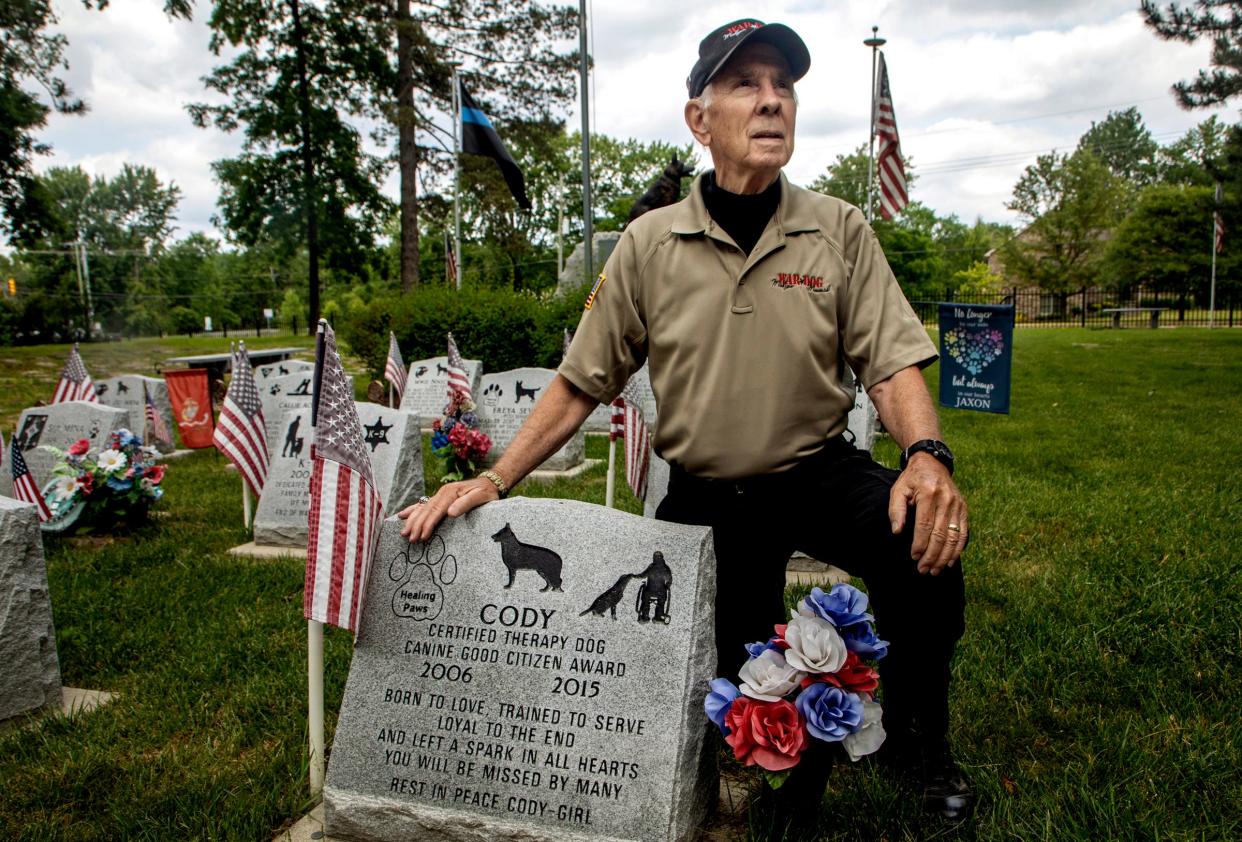
In 1969, the U.S. military drafted John Meeks to serve in the Vietnam War — a bleak prospect for the 18-year-old, only made tolerable because of the partner the Army assigned to him: Artus, a 6-year-old German shepherd.
"He knew more about what the hell was going on than I did," said Meeks, 73.
Meeks was Artus' handler for eight months in Vietnam. Artus sniffed out bombs, alerting the squad before they detonated, and he warned of ambushes, allowing Meeks and others to avoid them or be prepared to defend themselves. In one instance, Artus blocked Meeks and 15 others walking behind them from moving forward because he'd found a trip wire that would have detonated a bomb, killing all of them.
"He was a great dog," Meeks said. "To this day, I give him most the credit for allowing me to go home without a scratch. He saved me a couple of times. I owe him a lot.”
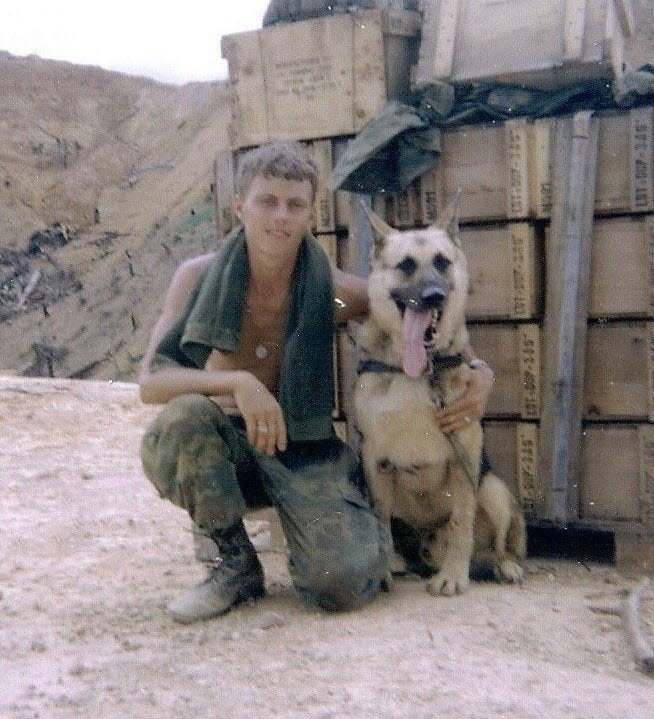
Some 4,200 working military dogs who served in Vietnam are credited with saving the lives of 10,000 soldiers there, according to the Vietnam Veterans Memorial Fund. The dogs' keen senses, especially to smell — which is about 50 times greater than that of humans, experts say — allowed them to alert soldiers of enemies, find explosives and warn of other dangers.
But when the war ended, the U.S. government did not bring the nearly 2,000 surviving military dogs home with the rest of the soldiers. Instead, the government left the dogs behind to be euthanized.
"It was a hell of a way to treat the dogs that saved so many lives," said Meeks, who lives in Kokomo, Indiana. "Just a hell of a way to show appreciation. It was really, really bad."
It's painful memories like those that spurred a place of honor in Michigan to memorialize hero dogs like Artus and so many others who serve, and sometimes sacrifice their lives, to save humans. It is the Michigan War Dog Memorial.
The project is the work of Michigan veteran Phil Weitlauf, 81, the president and director of Michigan War Dog Memorial, Inc. It is a nonprofit he started 11 years ago to operate the Michigan War Dog Memorial cemetery in Lyon Township, an old pet cemetery in western Oakland County that he and hundreds of volunteers restored. The 2-acre cemetery's purpose now is to honor all the military working dogs, police and other service dogs with monuments, special headstones for interment and elaborate military funeral services.
"They did their job and brought their handlers home safe," Weitlauf said. "The only flaw I can find with these animals is their lives are too short. That's why we take care of them at the Michigan War Dog Memorial."
The site is the sacred burial ground for the remains of some unique animals throughout history, including many heroic military, police and service dogs. It has become arguably the most prestigious place in the country for a working dog to be interred, said Weitlauf and handlers who traveled from other states to lay their dogs to rest there.
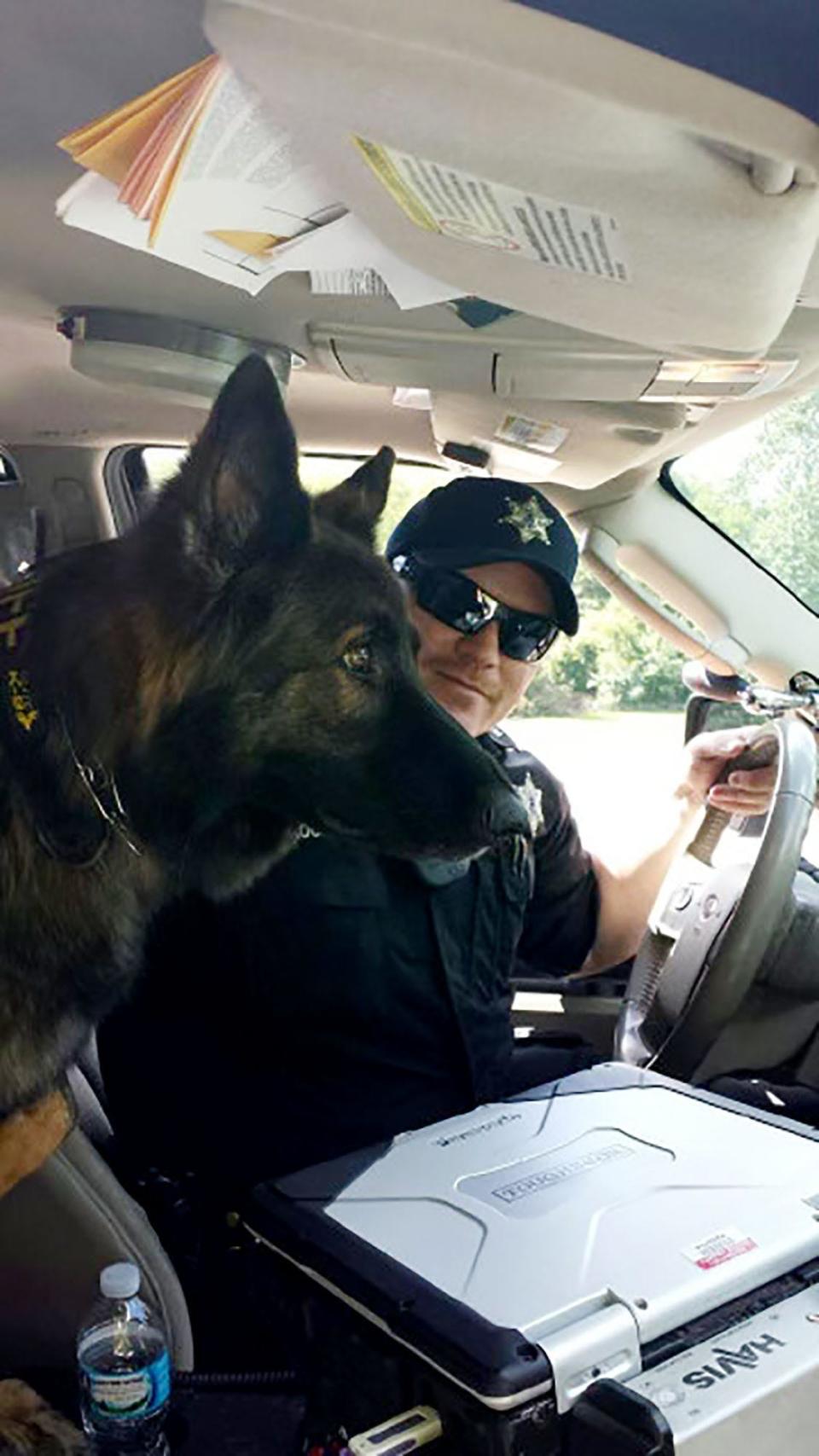
“There are not enough words to express how much I appreciate what Phil did in putting that place together and being able to go there and honor the dogs," said Richard Brooks, a retired dog handler with the Wayne County Sheriff’s Department.
Brooks, who lives in Westland, worked with and later adopted Gunner, a German shepherd trained to detect drugs, do tracking and protection work. In February 2019, Gunner died at nearly age 10. Shortly after his death, Brooks had Gunner's ashes interred at the Michigan War Dog Memorial. He visits Gunner's grave regularly to make sure "his flag is up, the one with our picture on it, and his American flag." Brooks keeps Gunner's Kong toy on his grave.
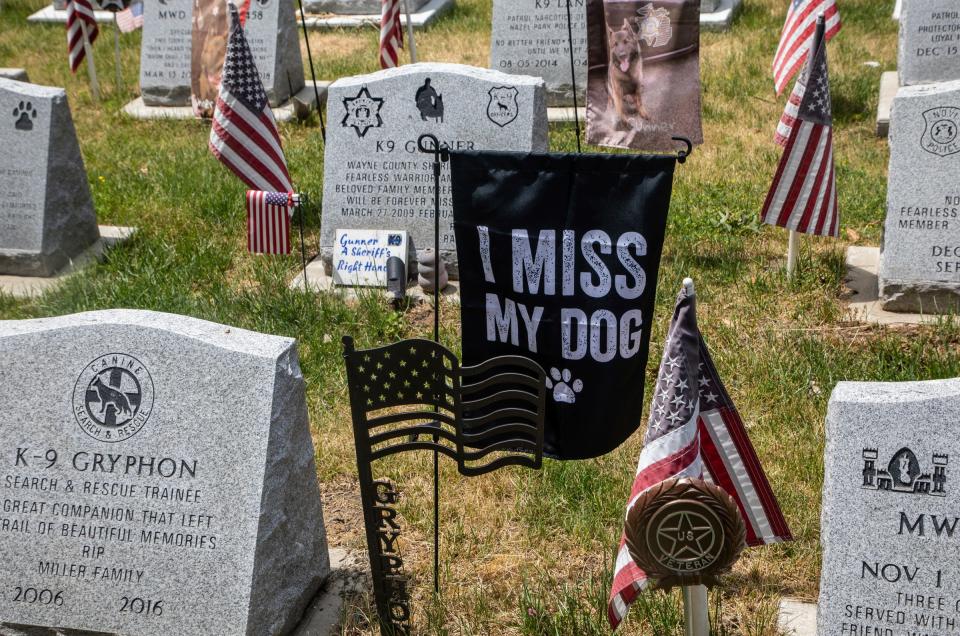
“I know how much it means to the handlers because we know how much those dogs mean," Brooks said, adding Gunner saved his life many times while on patrol. "Their whole life is dedicated to service and they don’t get to live long.”
Honor those dogs
Since Michigan War Dog Memorial was established in 2012, 75 service dogs from all over the country have been buried there. The cost is free to the handlers because Michigan War Dog Memorial pays with donations for the uniform headstones that line the area where the service dogs are buried. It costs about $1,000 to inter one dog. The group will bury 15 more dogs this year, Weitlauf said. One donor has sponsored five of them.
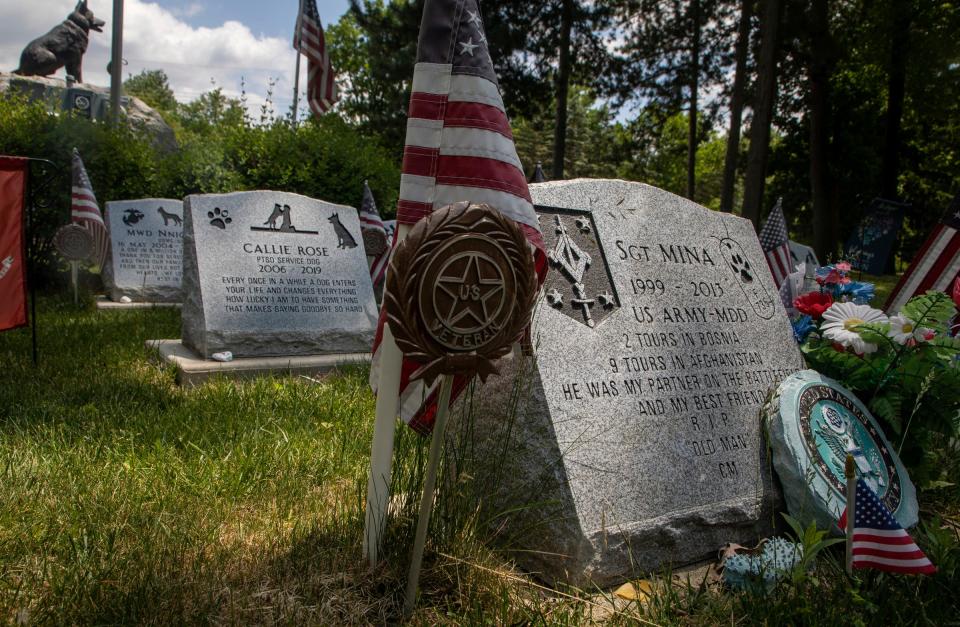
But only police and military dogs' remains go in the ground — and they must be cremated first to conserve the limited land space, Weitlauf said. The site is land locked and will eventually run out of ground room. So in 2019, the group bought a columbarium with 96 niches in it to inter ashes for other kinds of service dogs. It has 16 niches filled now.
While the ceremonies are sacred to Weitlauf, one of his proudest moments came in 2017 when the Michigan War Dog Memorial unveiled a Vietnam Memorial Wall that Weitlauf raised $40,000 to build because, "We need to honor those dogs who never came home from Vietnam."
The black granite wall, that is 5 feet tall and 20 feet long, depicts the names and military tag numbers of all 4,234 dogs to serve and die in Vietnam, including Artus — misspelled Artu on the wall with his number KO12 — who was killed by the Viet Cong on Dec. 11, 1970.
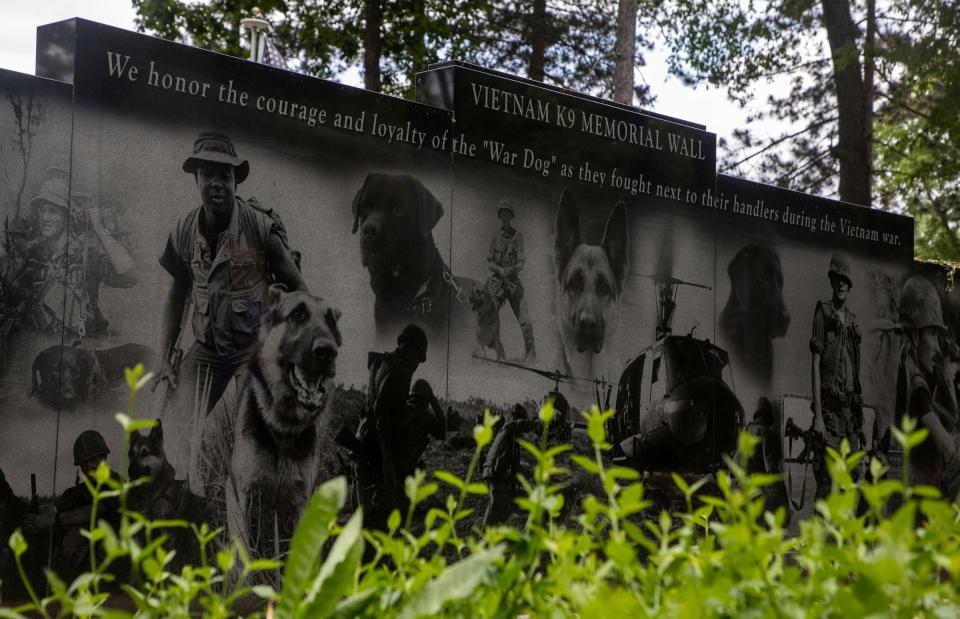
“I said to the dog handlers at the ceremony, ‘Go find your dog,' " Weitlauf said, recalling that there were about 200 people there. "They scurried over there and I saw their fingers go down the list and pointing to their dog. It was very emotional for them. They said, ‘After 50 years, my dog is finally recognized.’ "
Meeks was one of the handlers there for the unveiling of the wall.
"I have two dogs on that wall: Gretchen, who I trained with in the States, she went to Vietnam the same time I did but they wouldn’t let me have her and I ended up with Artus," Meeks said. "It’s very emotional. There isn’t a day that goes by now that I don’t think about him. I am able to live and breath because of him."
In recent years, Meeks has adopted retired military service dogs as pets. The ashes of two of them: Sgt. Abel and Sgt. 1st Class Brutusz are buried at the Michigan War Dog Memorial.
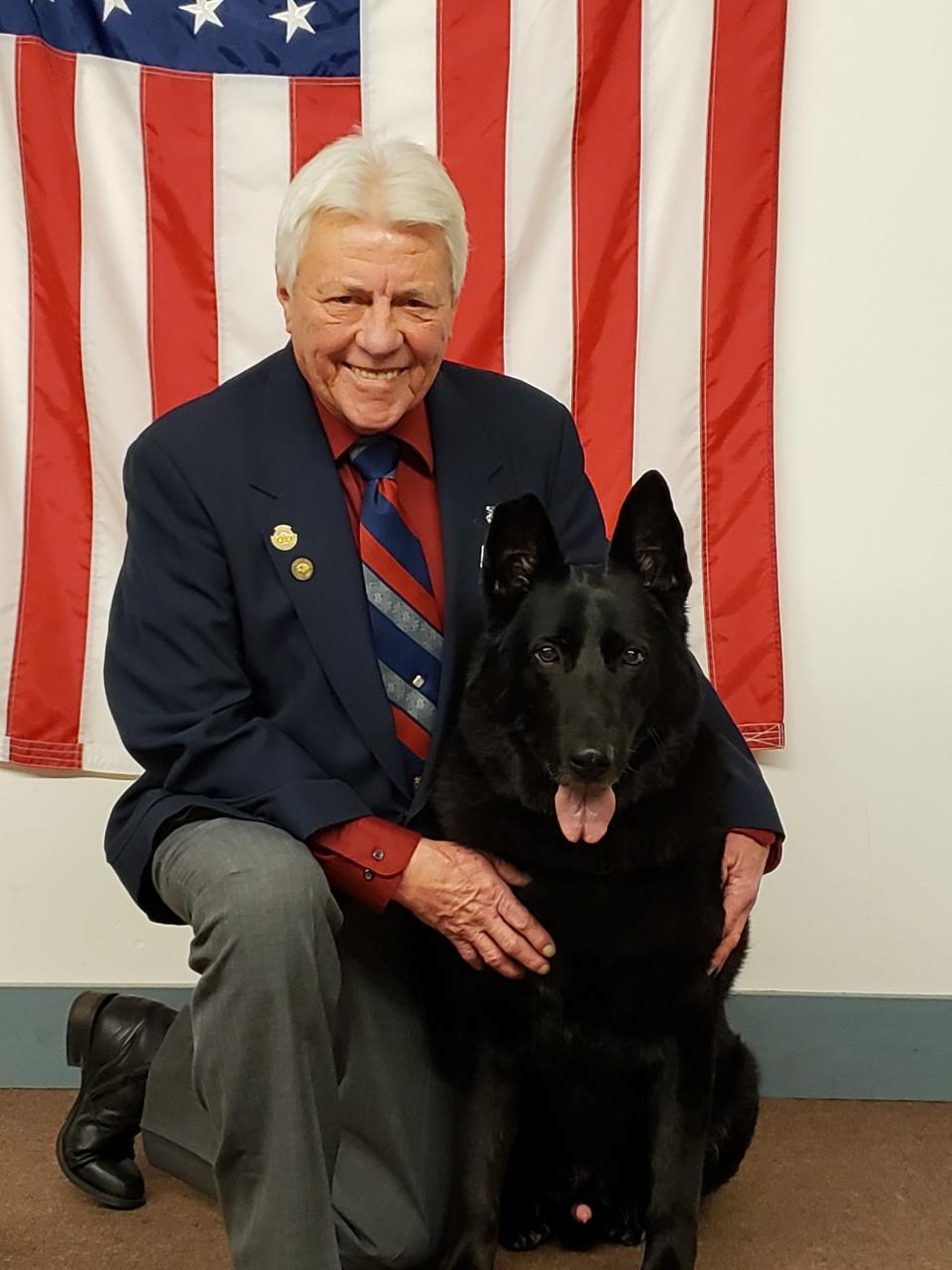
"I wanted to take both of them up to Michigan and they are now lying with other dogs that served their country," Meeks said. "I wanted them to be with their brothers and sisters like I want to be with mine. When my time comes, I will be at Marion National Cemetery (in Indiana) and be buried there where other veterans are.”
A 'brave warrior' is laid to rest
In the early afternoon of June 17, about two dozen motorcycles lined the shoulder of 11 Mile at Milford Road, the Michigan War Dog Memorial's location. The leather-clad, tattooed riders were scattered up and down the path of honor, the walkway leading inside the cemetery. Like many of the other 100 or so people milling about that day, the bikers were mostly military veterans there for the services of two military dogs: Lucky6, who served in the Army and Colt, who served in the Marine Corps.
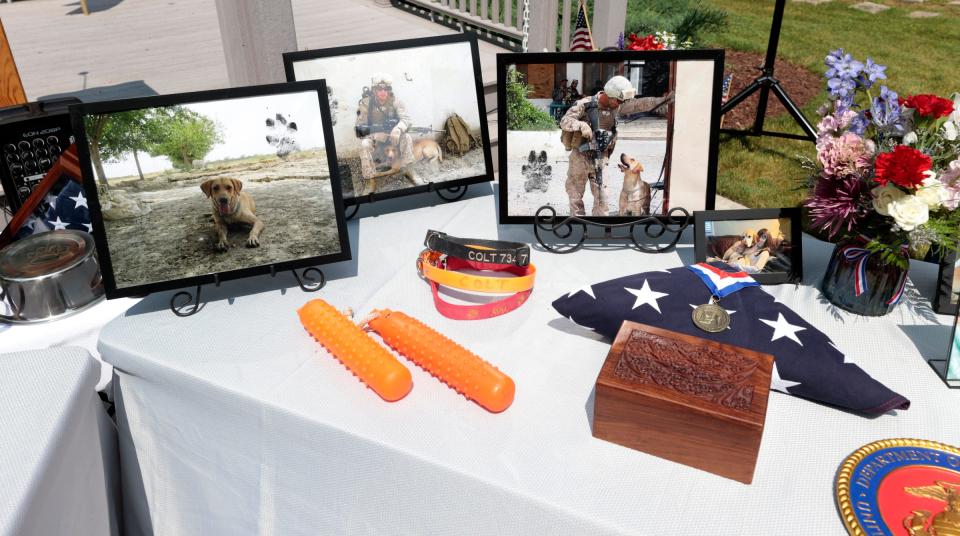
Also in the crowd was Ray Thomas, the director of the Royal Australian Air Force Dog Handlers Association. He’d come from Australia to see the place and observe the ceremony. He said about 2,500 dogs have served in the Australian Air Force to date with no special memorial or resting place.
“We want to have a look and see what it’s all about and hopefully, in time, we’d love to have something exactly like this in Australia … possibly in Queensland,” Thomas told the Free Press. “The veteran dog handlers that we have, they’d love to see something like this.”
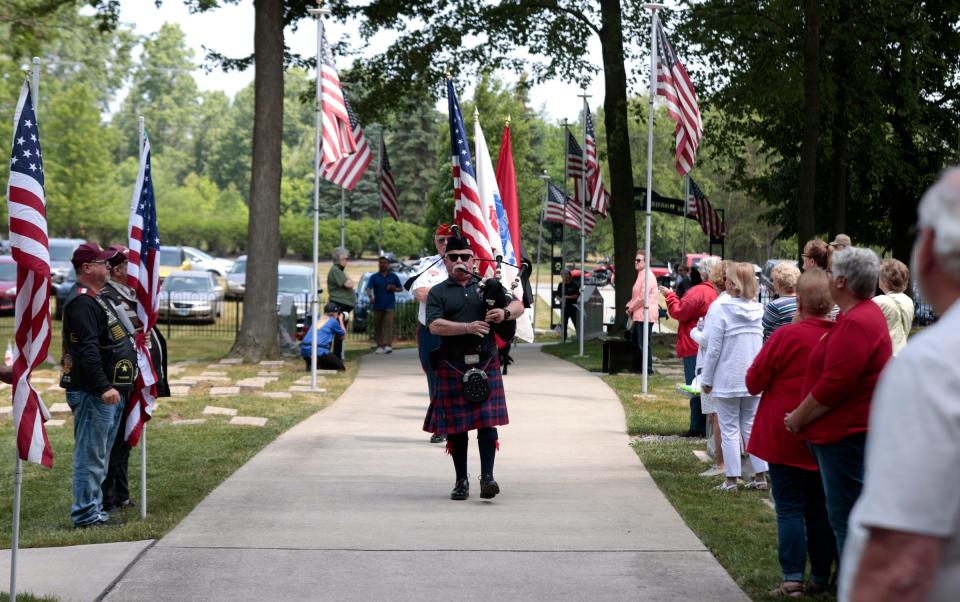
Soon, the crowd quiets as retired Oakland County Sheriff's Detective Dave Wurtz — wearing a traditional kilt — begins playing the bagpipes to mark the start of the ceremony. He leads a procession of 12 dogs, mostly German shepherds — called the K9 Salute Team. The dogs escort the handler, who is carrying the remains of his or her dog. There is an honor guard, the Marine Corps League from Howell. That day, and most of the funerals, includes the Patriot Guard Riders, who describe themselves as people who love motorcycles and have a respect for "those who risk their lives for America's freedom and security." The riders lined up on both sides of the stage with the American flag, facing the audience — tough looking guys, but look closer and you see their tears.
Weitlauf serves as a master of ceremonies. He leads the Pledge of Allegiance, then introduces the chaplain, a retired colonel in the Air Force, who does the invocation. Weitlauf then invites the dogs' handlers to the podium to eulogize their dogs.
“It’s usually very difficult for them, but I tell them, 'You owe it to your dog,' " Weitlauf said.
Ryan Schnettler, a retired Marine who now lives in Livonia, takes the stage that day. Below him, on a table sits a picture of Colt, the yellow Labrador retriever trained in bomb detection. Schnettler was Colt's handler in Afghanistan from 2012 to 2013. He was able to adopt Colt in 2013 after the dog retired. Colt died on Feb. 19 at age 11.
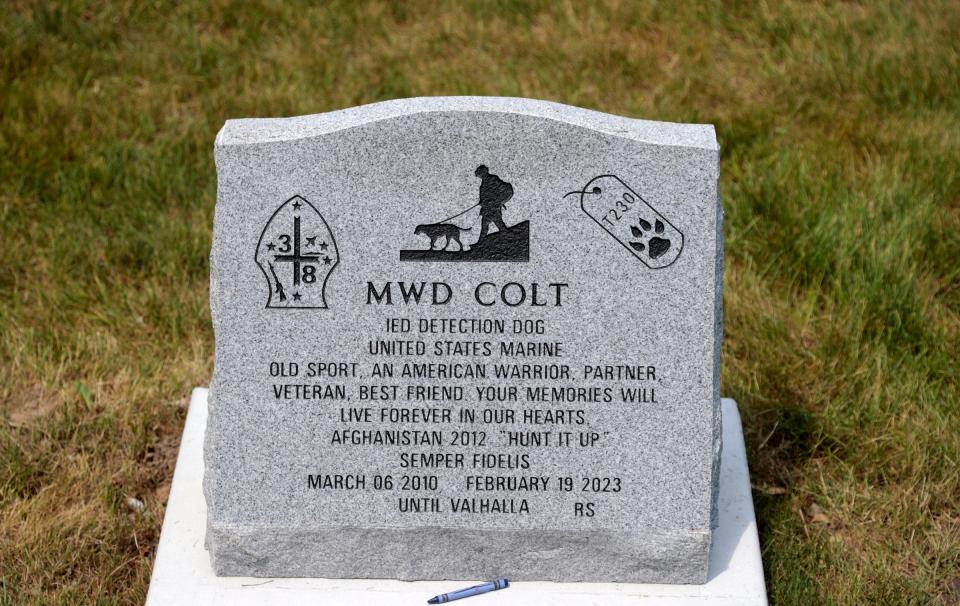
"Colt was a Marine, but he was also a beloved member of our family," Schnettler said in his eulogy. "He was loyal, devoted, which brought joy and happiness to everyone who knew him. We shared an unbreakable bond and Colt knew to be nearby when I was expressing some kind of emotion. I love you Colt and loved having you by my side and losing you hurt so much. You will be missed, but your memories will live forever in my heart. You will never be forgotten. You were a brave warrior who completed your mission. Rest easy, my friend.”
'Goodbye My Friend'
After the eulogy, a military member presents a folded American flag to each of the handlers and thanks them for their dogs' service to their country. The handlers are given a plaque with a photo of their dogs and then Michigan War Dog Memorial's artist, Barbara Strong, of Livonia, presents them with framed hand-drawn portraits of their dogs.
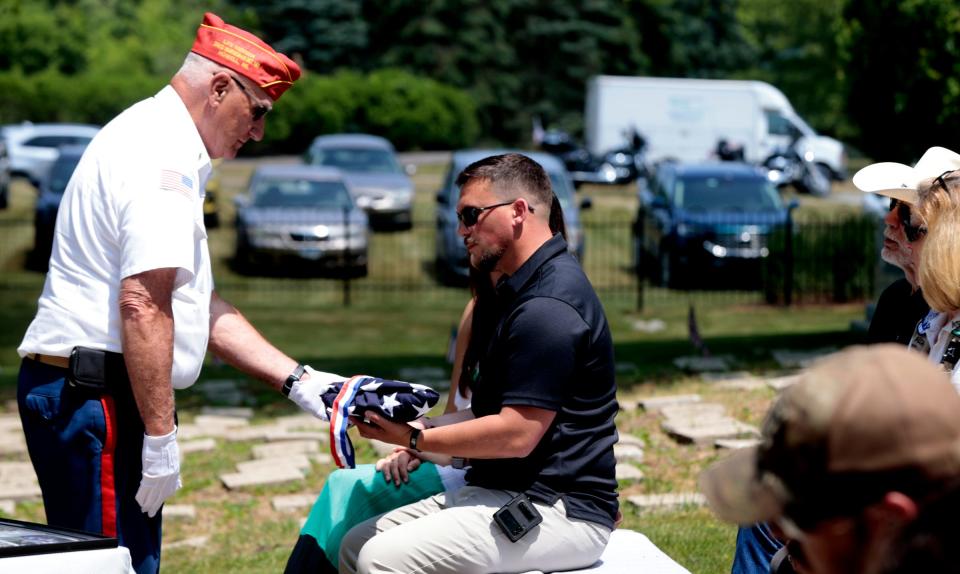
Retired Army veteran Jim Marinelli raises his bugle and plays a soulful rendition of taps; he's followed by "Amazing Grace," by Wurtz on the bagpipes. Four of the dogs on the K-9 Salute Team, led by a German shepherd named Gus, then howl on command for 20 seconds to bid farewell to their deceased brothers.
"It's an honor to pay tribute to these dogs," Marinelli told the Detroit Free Press. "Some people don't realize how much these dogs did to save lives."
The 30- to 45-minute program ends with the missing dog formation, where the K9 Salute Team walks up the path of honor and one dog breaks off and goes behind the stage as the others carry on. The song, "Goodbye My Friend" by Linda Ronstadt plays in the background.
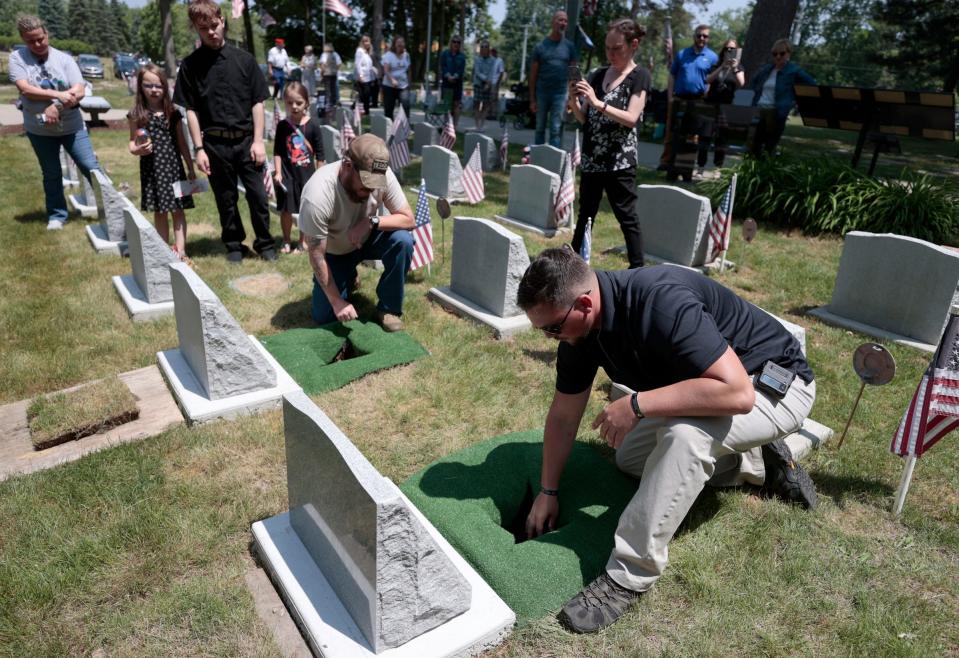
Later, the handlers will place their dogs' ashes into the small grave under their headstones. If you look around, you see keepsakes on many of the graves: a teddy bear, flowers and a flag, a well-worn ball made of string and a painted rock that reads "Peace to you."
There are also coins scattered across many graves with special meaning: A penny means a person visited the grave, a nickel means the visitor trained with the deceased, a dime means the visitor was deployed with the deceased and a quarter means, "I was there when you were killed or died," Weitlauf said.
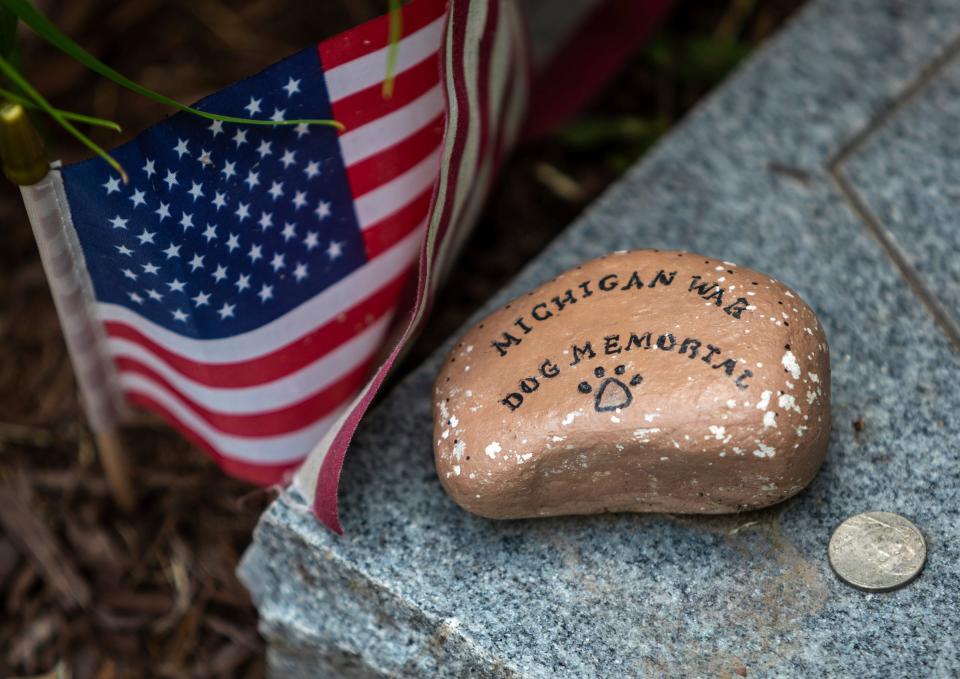
Weitlauf sits quietly on a bench after the crowd disperses that Saturday. His usual intensity and focused energy has faded into the kind of lightness that accompanies deep satisfaction. A slight smile sneaks across his face. He knows he did his duty that day. He honored these dogs.
A passion project
Weitlauf, who was born in Alabama, grew up in Stockbridge, Michigan, after his parents moved there when he was 5. He served in the Army from 1962 to 1964 and then spent four years in the Army Reserves. He spent his career in the auto industry, selling parts for the assembly lines to the Detroit Three automakers.
But it was in retirement that Weitlauf found his true calling. A lifelong dog lover who grew up with mostly German shepherds, his friends knew he followed the stories of military dogs. So, on a spring morning in 2010, Weitlauf visited the abandoned pet cemetery in Lyon Township on the recommendation of a friend who told him about the granite memorial to war dogs.
“All I saw was a wooded area," Weitlauf recalled of the overgrown site. He looked down at his German shepherd at the time, and said, "Cody, someone should do something about this.” Days later, sipping his morning coffee in his retirement, he said to himself, "So Weitlauf, why don't YOU do something about it?"
He reached out to a few military veteran buddies and dog lovers asking for help clearing out the site. To his surprise, 55 people showed up to help and the number of volunteers grew as they kept clearing the site, day after day. He was eventually getting 100 people at a time to help.
“I said, ‘We've got something here. People want this done,’ “ Weitlauf said.
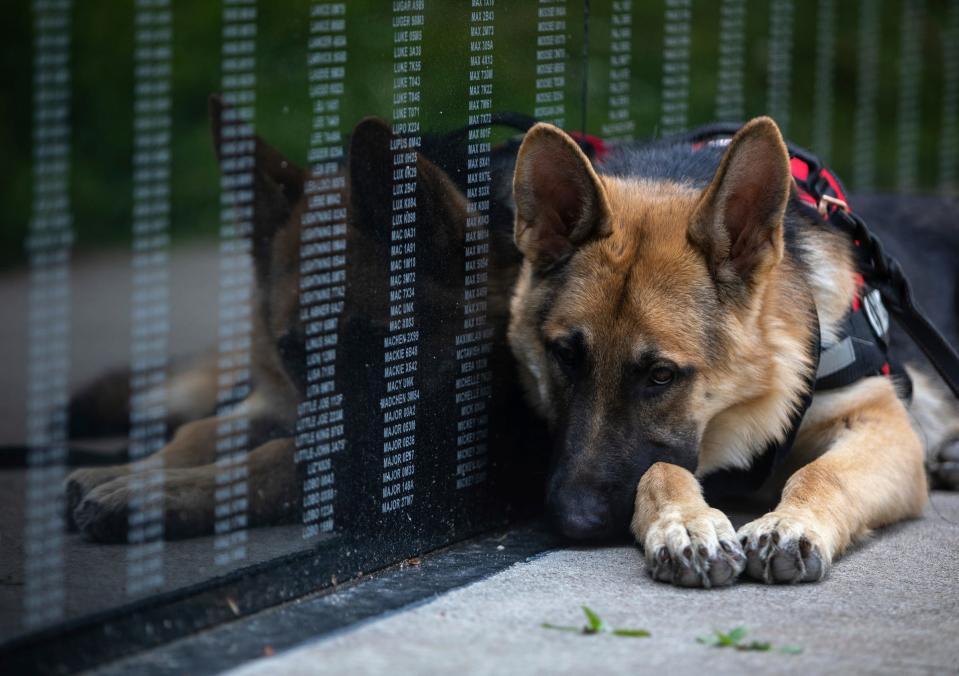
At that time, Lombardo Homes owned the property, Weitlauf said. He got its permission to clean it up and, in 2012, Lombardo Homes gave the property to the nonprofit he had formed.
Weitlauf had the land deeded to Lyon Township but has a contract that says his nonprofit has control over running it. The Michigan War Dog Memorial's Vice President of Operations Clint Symons, 49, will succeed Weitlauf one day in running the memorial to ensure it carries on.
"That’s always been my biggest fear. I have a tendency of getting vertigo and thought what would I do if it’s a Saturday morning and we have a burial ceremony and vertigo hits?" Weitlauf said. "Who can take over for me? I had a good feeling with Clint. He works at General Motors and he’s not afraid to get up and talk in front of people.”
Dogs joins WWII
To understand the importance of the memorial and the ceremony, one must first know a bit of history about dogs in the military. It is estimated that working military dogs saved some 28,000 lives in U.S. wars from World War II on, Weitlauf said.
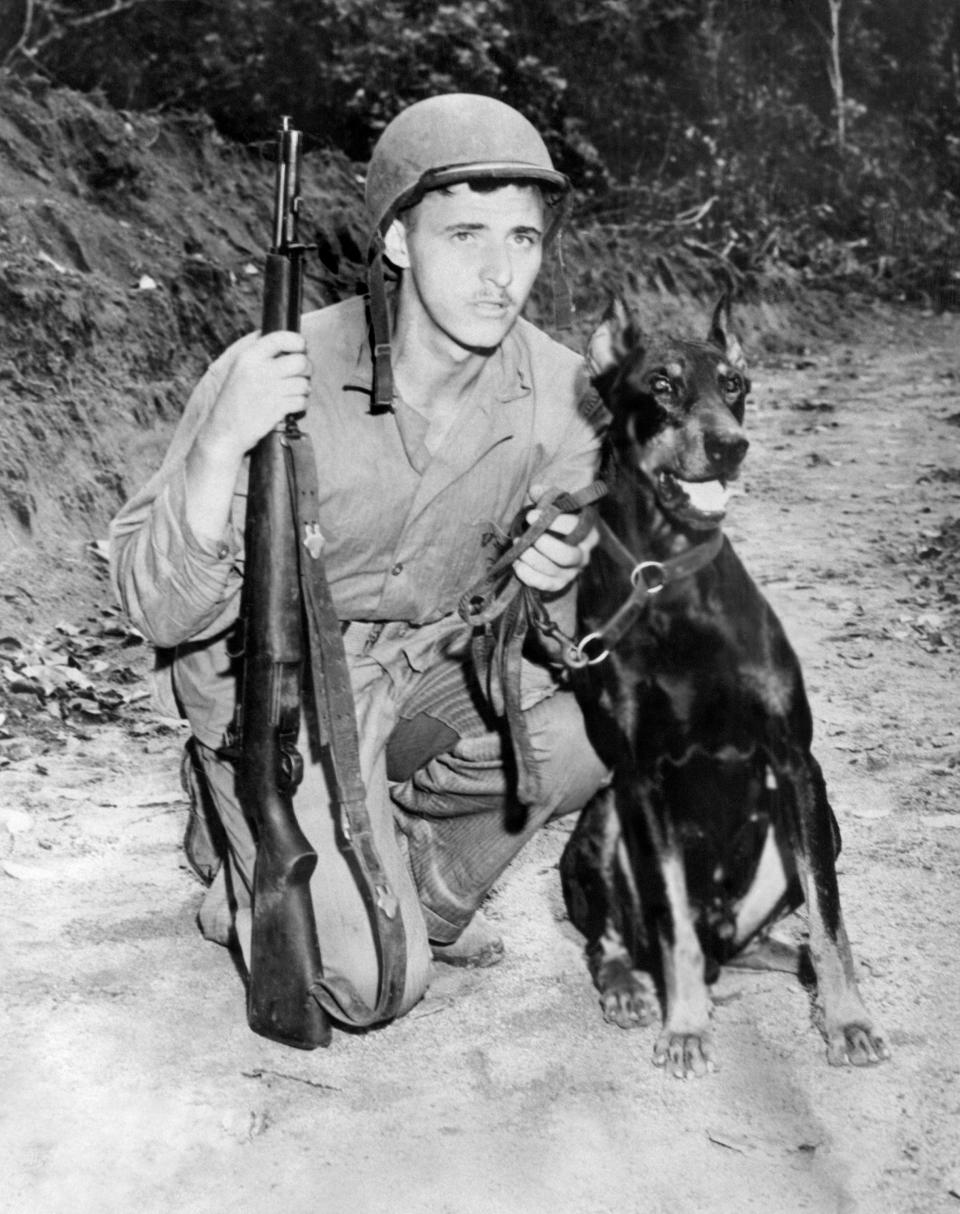
According to an article in the American Kennel Club, the U.S. military's official use of dogs started in 1942, when a private organization called Dogs for Defense was established to encourage people to volunteer their pet dog for the U.S. military’s War Dog Program, known as the K-9 Corps. The Doberman Pinscher Club of America also supplied war dogs that became linked with the U.S. Marines. The dogs were given a rank, starting as privates. In more recent years, the military established a rule that the dogs must always be one-rank above their handler, Weitlauf said. The reason for that is to ensure the dog is not mistreated because doing so would be assaulting an officer.
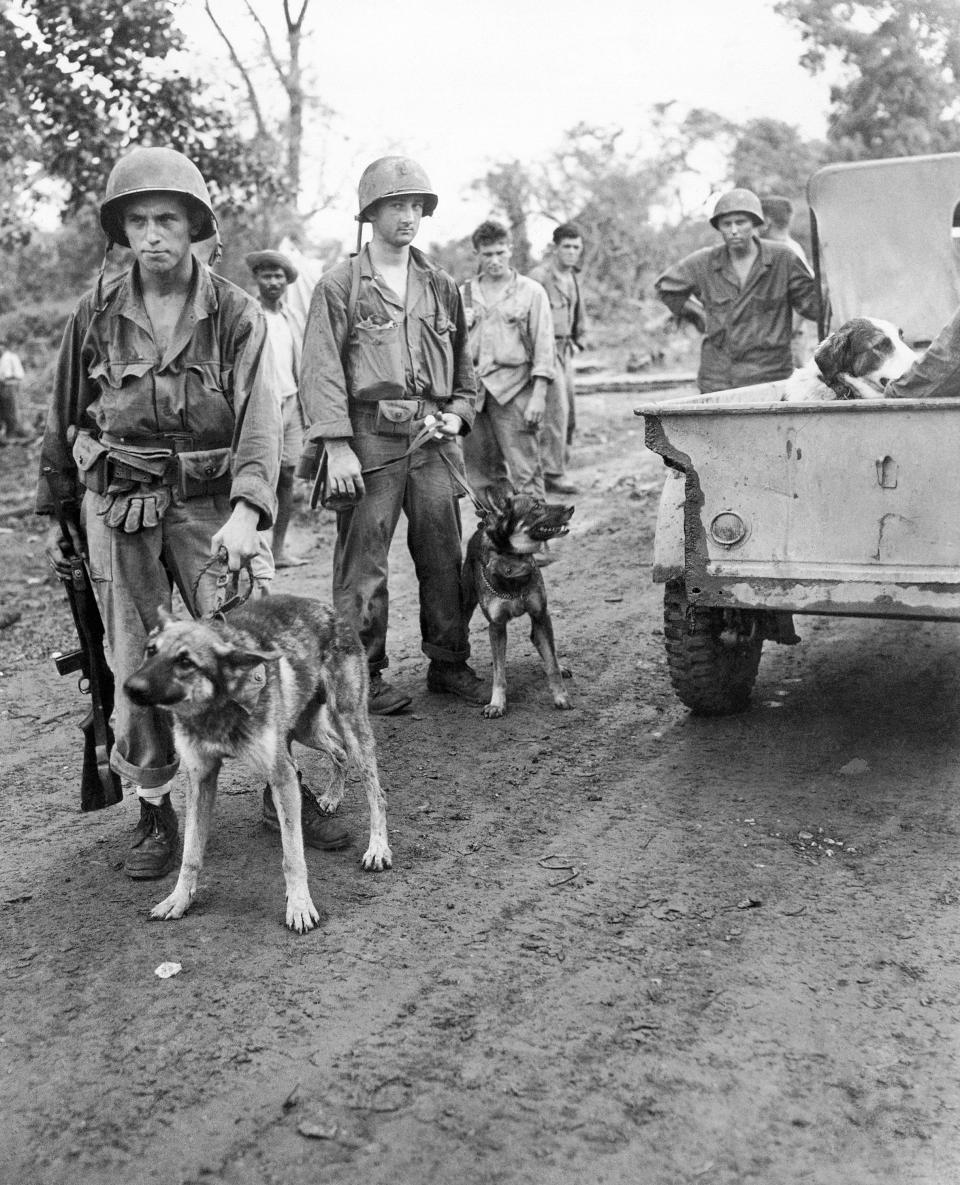
The dogs that did not pass the training for WWII were returned to their owners. Those who passed were sent to battle "from foxholes to beach fronts, where they were utilized for messenger, mine-detection, sentry and scout duties," the AKC said in the article.
By the end of the second World War, Dogs for Defense had recruited 18,000 of the 20,000 military dogs, the AKC said. One of those dogs was Chips, which the AKC said was a German shepherd/Alaskan husky/collie mix. Chips was donated by his family in New York and his lifesaving heroics earned him a Purple Heart and Silver Star.
Weitlauf said dogs are credited with saving about 15,000 lives during World War II.
'Take your dog and go home'
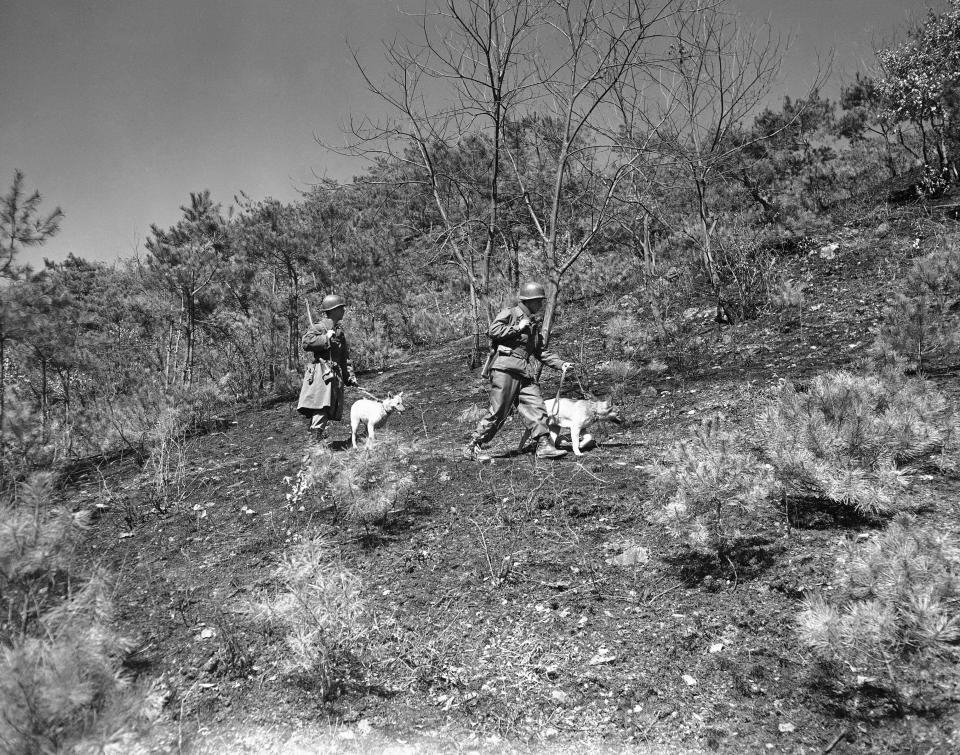
In the Korean War in 1950, the AKC wrote that dogs were deployed on combat night patrols and were hated by the North Koreans and Chinese "because of their ability to ambush snipers, penetrate enemy lines and scent out enemy positions. It reached a point where reports noted the foes were using loudspeakers saying, 'Yankee, take your dog and go home!' ”
Weitlauf said the dogs are credited with saving 3,000 lives during the three-year conflict in Korea and in the end, they were brought home.
From 1955 to 1975, during the Vietnam War, the dogs did a variety of duties: scout, guard duty, patrol, mine and booby-trap detection and combat. Again, the dogs were so hated by the Viet Cong, that they attracted a $20,000 bounty for their capture, the AKC said. Artus was one of those dogs, Meeks said, noting his killers took his body likely to collect a bounty.
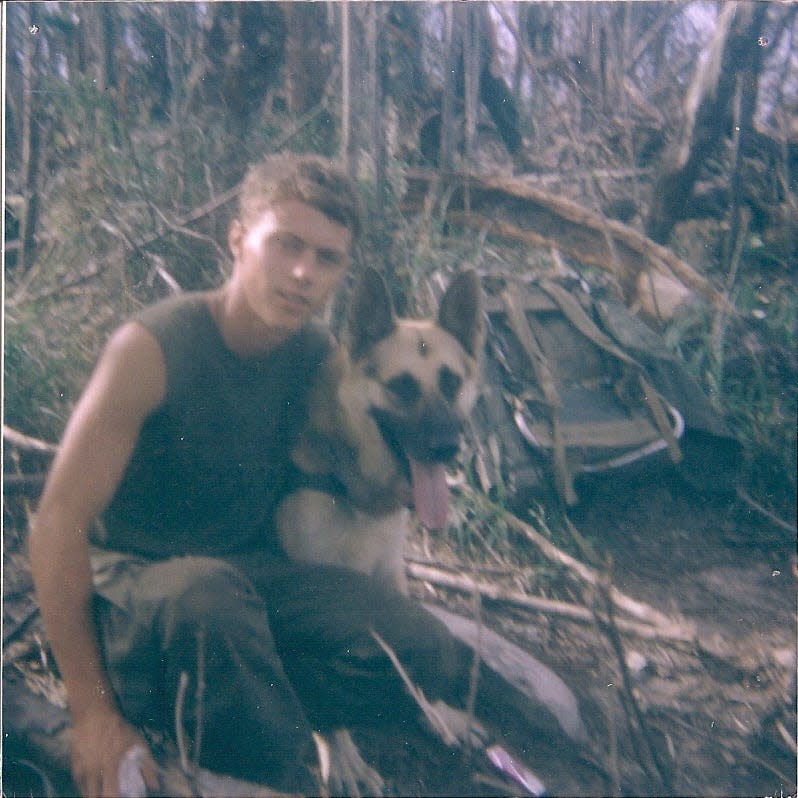
In the end, the U.S. government abandoned thousands of the dogs because, "They claimed the Centers for Disease Control was concerned of the dogs bringing diseases home," Weitlauf said. "The handlers pushed back. They agreed to a lottery to bring 204 dogs home and quarantine them for 14 days. They did that ... no one showed any diseases. But Congress said this would still be a logistical nightmare to bring the rest back and quarantine them. So the order stands.”
Robby's Law brings dogs home
One of the dogs to make it back through that quarantine lottery was Gretchen, the 55-pound silver German shepherd who Meeks first met in training.
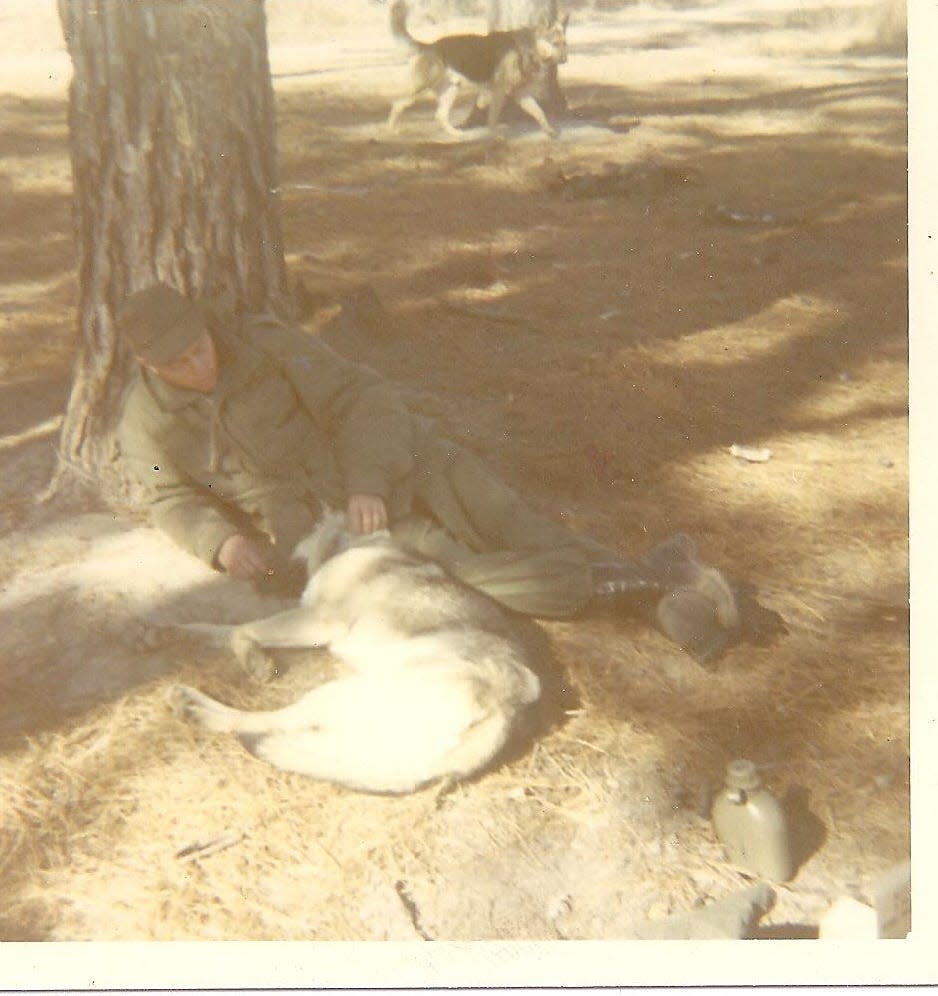
"I tracked it down years later and found out that the government retrained her as a drug dog and shipped her to North Dakota and she spent the rest of her life in the Air Force there," Meeks said. "So that was good to hear that about my little dog.”
Today, military working dogs are brought home. In 2000, due in part to lingering public outrage after what happened to the dogs in Vietnam, Congress passed Robby’s Law that President Bill Clinton signed. It requires that all military dogs suitable for adoption upon their retirements be made available for adoption and not euthanized.
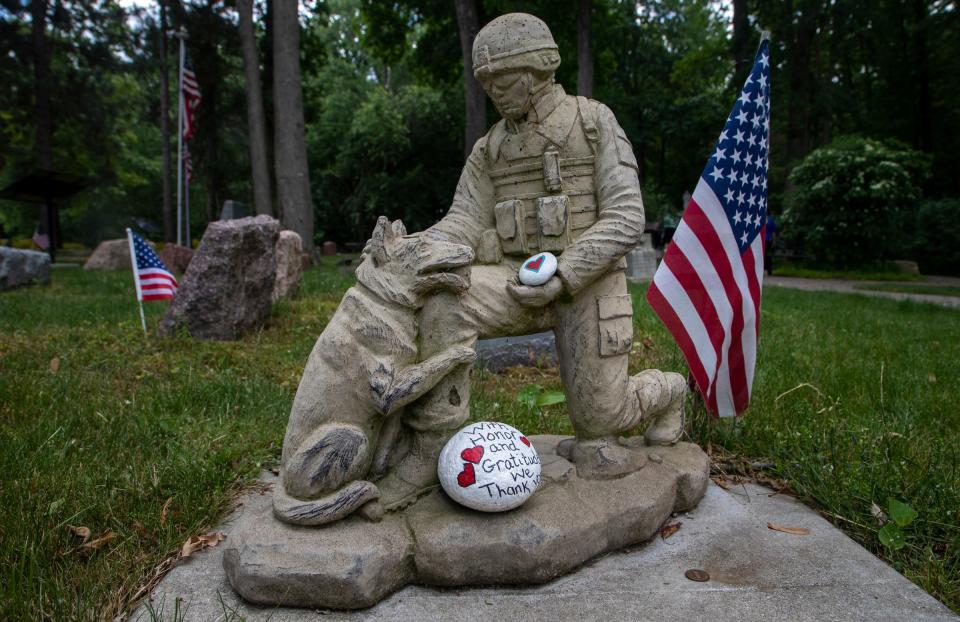
But the dogs are still classified as equipment, not soldiers, Weitlauf said. He is an advocate for the passage of H.R. 9077, known as the Canine Members of the Armed Forces Act. It would change military dogs' status to members of the armed forces, not equipment. The dogs would get medical care when released from duty. U.S. Rep. Elissa Slotkin, D-Lansing, introduced the measure last fall and it is in committee.
For subscribers: A gardener's find and a chance encounter: WWII dog tag lost in France back home in Indiana
Famous first pets at the cemetery
When Weitlauf first stumbled upon what is now the Michigan War Dog Memorial site, it was called Happy Hunting Ground Pet Cemetery. The Elkow family established it in 1936 and ran it until 1975, burying about 2,300 animals there. It was abandoned by 1985. But there are graves that date to the 1930s for dogs, cats and even one unique parrot: U.S. Navy Admiral George Dewey’s mascot parrot. A gravestone for the bird from 1938 is at the cemetery. Another notable gravestone there is for Blizzard, a sled-dog during Adm. Richard Byrd’s Antarctic expedition from 1928-1939, Weitlauf said.
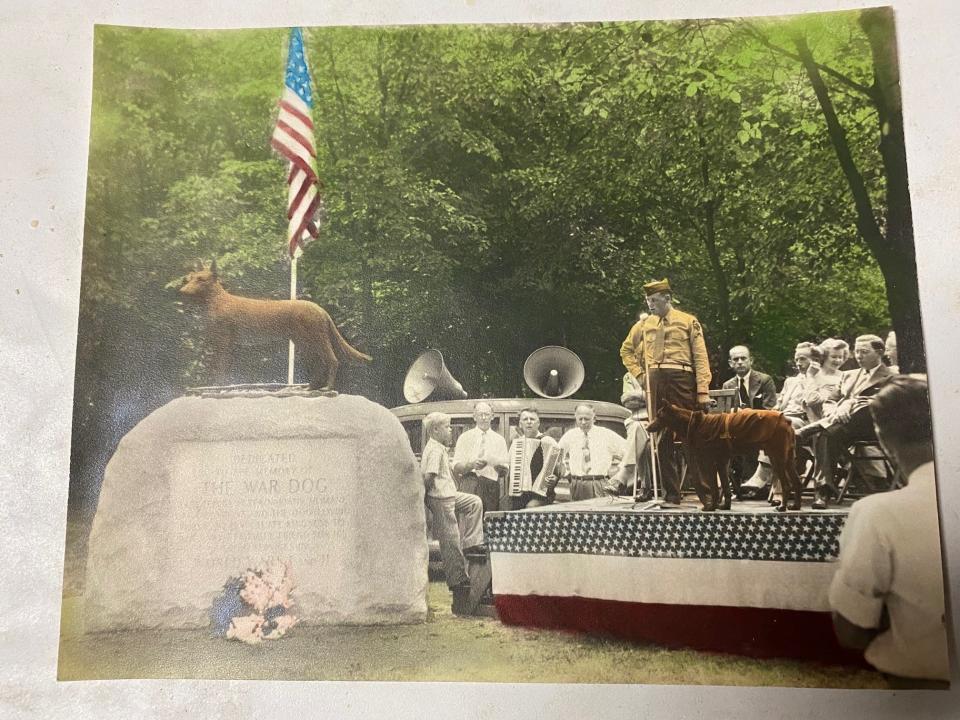
One of the first military dogs to be buried there was Sgt. Sparks in 1947. Sgt. Sparks was a Doberman pinscher whose family in Ohio donated him to the military during World War II. He joined the Marines where he excelled and was promoted from private first class to corporal to sergeant, according to an article about him in a 1977 edition of Leatherneck, a magazine for Marines that Weitlauf shared.
He survived duties in Bougainville, Guadalcanal, Okinawa, and Guam, according the article. He returned a hero, having alerted soldiers to ambushes and saving lives, according to the article. Marine Cpl. Jack Patterson, of Rochester, adopted Sgt. Sparks after the dog returned to the United States and was retired.
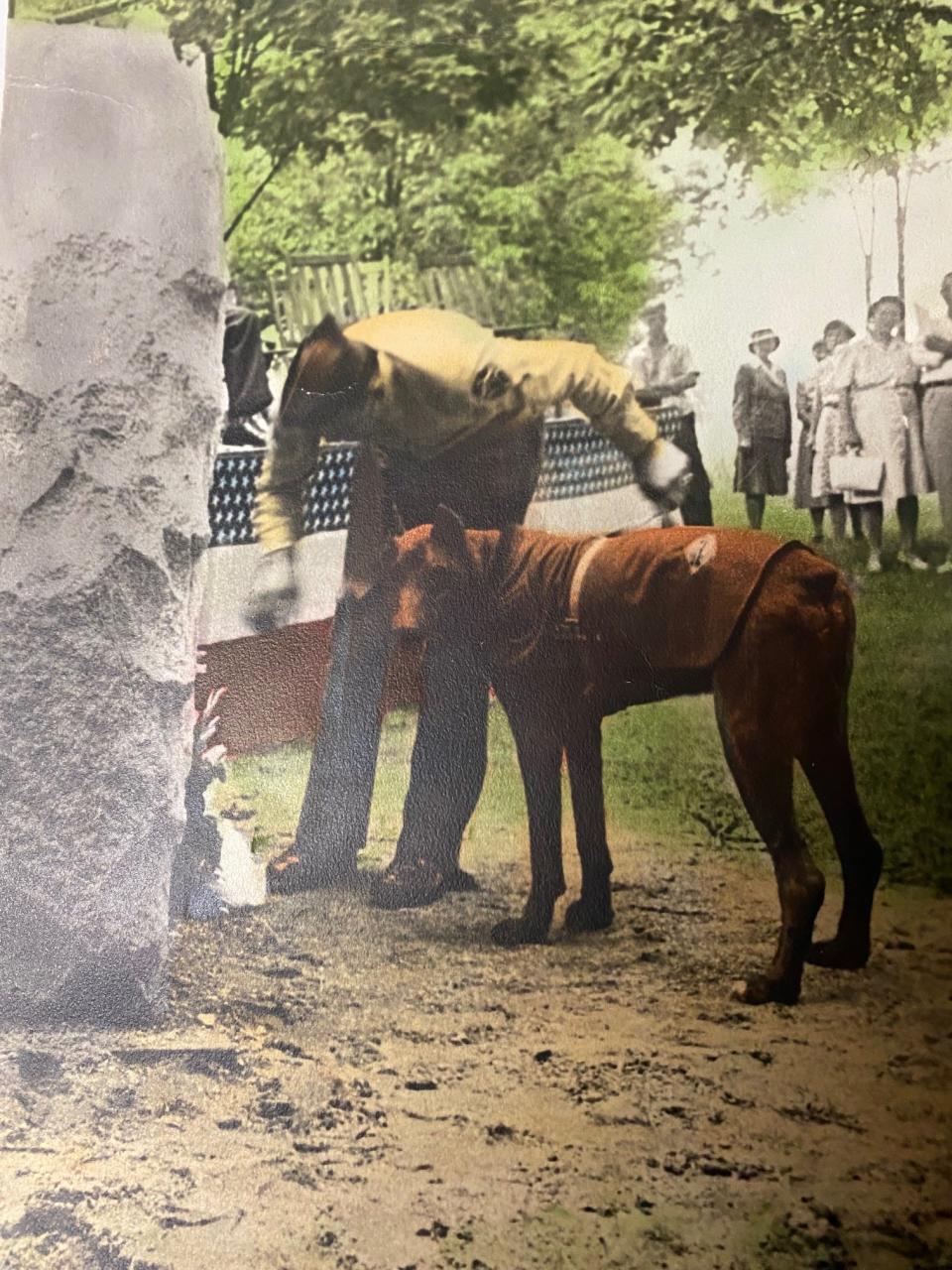
With sentiment high, Lyon Township residents contributed more than $3,700 in 1946 (about $57,000 today) to erect a 16–ton granite monument as a tribute to dogs in military service. Sgt. Sparks was on the stage to help officiate the ceremony. A year later, Sgt. Sparks was dead after someone poisoned him near his home, Weitlauf said.
These dogs have jobs: Very important (and sometimes ruff) hotel jobs
Burying 'The Old Man'
In 2013, Michigan War Dog Memorial buried the first military dog since it took over: A Chesapeake Bay retriever named Buddy. Buddy was trained at Lackland Air Force Base in San Antonio, as an explosive detection dog.
The second military dog to be buried there was a male black Labrador retriever named Mina. Mina did two tours in Bosnia with the British Army and then he was transferred to the U.S. Army and did nine tours in Afghanistan, Weitlauf said.
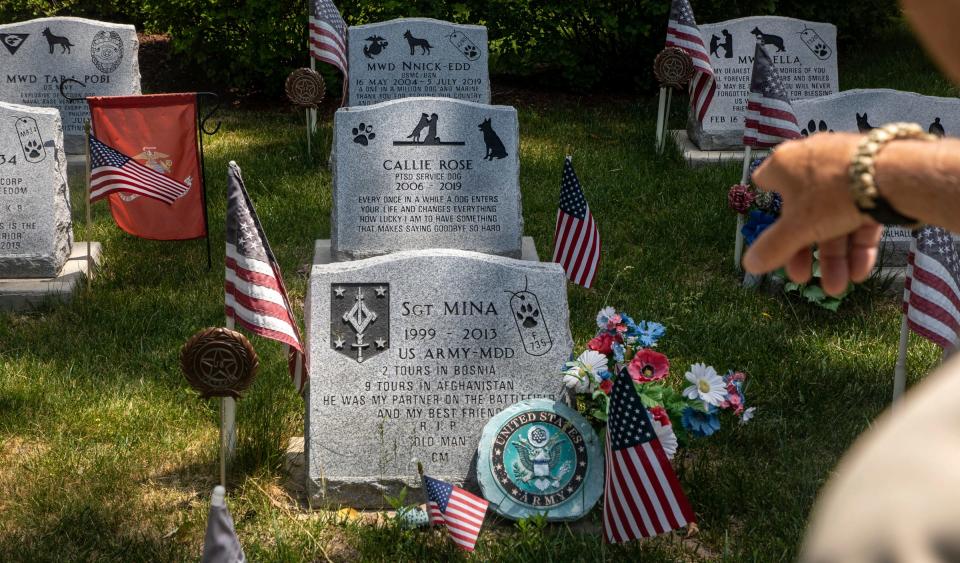
"He was so good at explosive detection they didn’t want to let him go. He was 99.9% accurate so the Army kept him on," Weitlauf said. "His nickname was 'The Old Man' because he competed against these 1- or- 2-year-old dogs and he’d outperform them.”
His handler was from Owosso, Michigan, and adopted Mina when the dog retired in 2012. He lived in Owosso for 18 months before he died at age 14.
Saving lives and keeping company
Another furry warrior to be buried at Michigan War Dog Memorial cemetery on June 17 alongside Colt was Lucky6.
A black German shepherd, Lucky6 served in the Army with Howell resident Jonathan Van Dyk. Van Dyk and Lucky6 were deployed to Afghanistan from 2012 to 2013. Van Dyk was the dog's handler only for that year, then the military transferred Lucky6 to work with the military police. But Van Dyk said he spent the next five years looking for his dog.
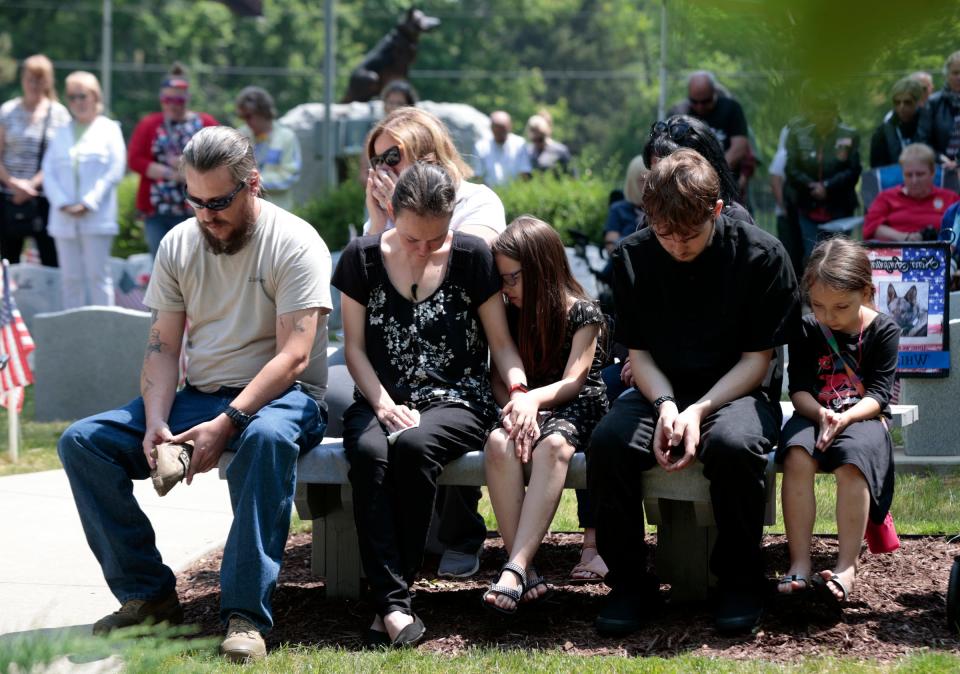
“He’s my best friend," Van Dyk told the Detroit Free Press. "We spent every minute together...He saved my life multiple times. He kept me out of places I shouldn’t have gone. It’s hard to get away from somebody who keeps your life safe, keeps you company when you miss home.”
Van Dyk estimates Lucky6 saved about 200 lives during their year together. He was able to adopt Lucky6 in 2018 when the dog was retired. The two were together for four and a half years until Jan. 14 when Lucky6 died at age 13. It meant the world to Van Dyk that his best friend be laid to rest at the Michigan War Dog Memorial, he said. It gives him comfort knowing that Lucky6 is buried in good company, that his service is honored and he is remembered, Van Dyk said.
"It’s hard to say goodbye. I don’t want to," Van Dyk said, standing over the grave where he'd just placed Lucky6's ashes.
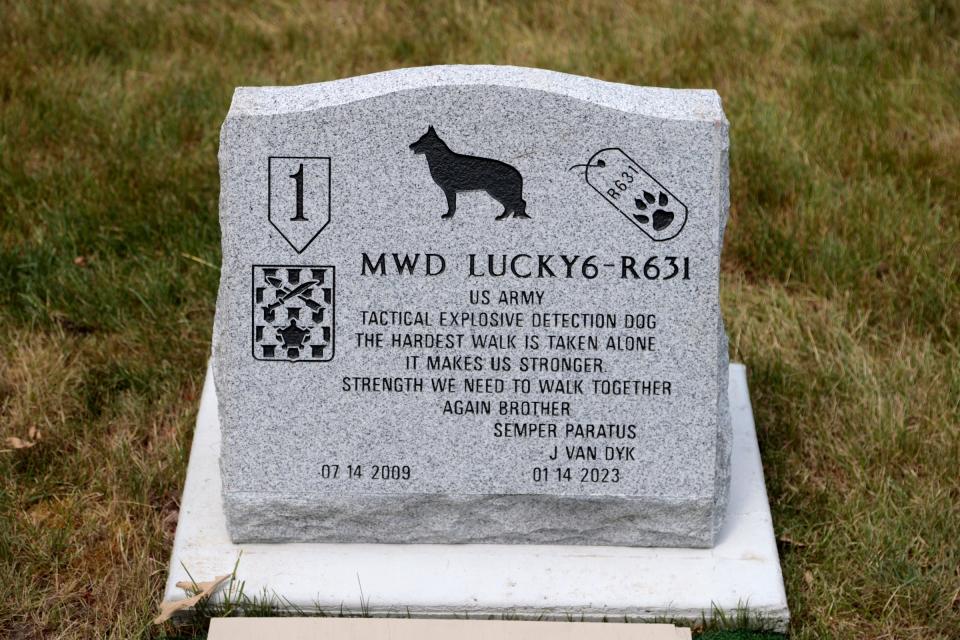
The headstone has Van Dyk's inscription and signature. He borrowed a verse from Semper Paratus, the U.S. Coast Guard theme, to honor his dog: "The hardest walk is taken alone. It makes us stronger. Strength we need to walk together again brother."
To learn more about the Michigan War Dog Memorial or make a donation visit www.mwdm.org.
Contact Jamie L. LaReau: jlareau@freepress.com. Follow her on Twitter @jlareauan. Read more on General Motors and sign up for our autos newsletter. Become a subscriber.
This article originally appeared on USA TODAY NETWORK: Michigan War Dog Memorial is cemetery for police, military dogs
